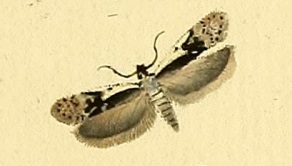
Anacampsis is a worldwide genus of moth with most found in the nearctic and neotropical regions. It is in the family Gelechiidae. The larvae feed on a range of deciduous trees and shrubs in a rolled or folded leaf, or spun shoot.

Parascotia fuliginaria, the waved black, is a species of moth of the family Erebidae. It is found in Europe as far east as the Ural Mountains, in Armenia and Asia Minor, and is an introduced species in North America.

Rhizedra lutosa, the large wainscot or Isle of Wight wainscot, is a species of moth of the family Noctuidae. It is native to the Palearctic realm. It has been introduced into eastern North America and is spreading.

Anacampsis populella is a moth of the family Gelechiidae, which is native to Europe and has been accidentally introduced to North America. It was first described in 1759 by Carl Alexander Clerck, a Swedish entomologist. The type specimen is from Sweden. The foodplants of the larvae are poplars and willows.

Lichenaula lichenea is a species of moth of the family Xyloryctidae. It is known in Australia from the Australian Capital Territory, New South Wales and Queensland.

Hellinsia inquinatus is a moth of the family Pterophoridae. It is found in North America, including Florida, Mississippi, Oklahoma, Tennessee, Maryland, Alabama, Texas, Missouri, Colorado and Arizona. It has also been recorded from Hispaniola, Mexico, Puerto Rico and St. Thomas Island.

Oidaematophorus grisescens is a moth of the family Pterophoridae. It is found in North America and Mexico.

Anacampsis scintillella is a moth of the family Gelechiidae. It is found in most of Europe, except Ireland, Great Britain, the Netherlands, Norway, Finland, most of the Baltic region and Poland.

Anacampsis blattariella, the birch sober, is a moth of the family Gelechiidae. It is found in most of Europe, except Ireland, the Iberian Peninsula and most of the Balkan Peninsula.
Anacampsis poliombra is a moth of the family Gelechiidae. It was described by Edward Meyrick in 1922. It is found in Brazil (Amazonas).
Anacampsis aedificata is a moth of the family Gelechiidae. It was described by Edward Meyrick in 1929. It is found in Brazil (Para).
Anacampsis rivalis is a moth of the family Gelechiidae. It was described by Edward Meyrick in 1918. It is found in Sri Lanka and southern India.
Anacampsis scalata is a moth of the family Gelechiidae. It was described by Edward Meyrick in 1914. It is found in Guyana and Brazil (Para).
Anacampsis kearfottella is a moth of the family Gelechiidae. It was described by August Busck in 1903. It is found in North America, where it has been recorded in Kentucky, Pennsylvania and New Jersey.
Anacampsis lagunculariella is a moth of the family Gelechiidae. It was described by August Busck in 1900. It is found in Panama, Cuba and the southern United States, where it has been recorded from Florida.
Anacampsis lupinella is a moth of the family Gelechiidae. It was described by August Busck in 1901. It is found in North America, where it has been recorded from Ontario, Florida, Illinois, Louisiana and Texas.
Anacampsis phytomiella is a moth of the family Gelechiidae. It was described by August Busck in 1914. It is found in Panama.
Anacampsis psoraliella is a moth of the family Gelechiidae. It was described by William Barnes and August Busck in 1920. It is found in North America, where it has been recorded from Iowa.
Anacampsis tephriasella is a moth of the family Gelechiidae. It was described by Vactor Tousey Chambers in 1872. It is found in North America, where it has been recorded from Illinois, Kentucky and Maine.
Anacampsis triangularis is a moth of the family Gelechiidae. It was described by Annette Frances Braun in 1923. It is found in North America, where it has been recorded from southern California.







